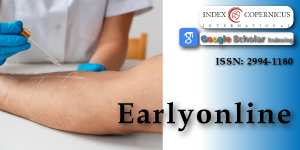Efficacy and Safety of Punch Elevation Combined with Dermapen in Treating Boxcar Post-acne Scars: A Paired Comparison Study in Syria
Main Article Content
Abstract
Background: Atrophic scars following acne vulgaris are considered an aesthetic, psychological, and social problem for patients, and despite the existence of many treatment options, finding modern treatments is a necessity to reduce side effects associated with current therapies and reduce the financial burden on patients.
Objectives: to evaluate the efficacy of punch elevation combined with dermapen in treating atrophic scars following acne vulgaris on the cheeks, and to evaluate patients' satisfaction with this procedure.
Methods: This clinical trial involved 19 patients to evaluate the efficacy of punch elevation combined with dermapen in treating post-acne scars.
Results: According to the Goodman and Baroon scale for acne scars, and after 6 months, the percentage of grade 4 decreased from 26.3% to 10.5%, grade 3 decreased from 73.7% to 31.6%, grade 2 increased from 0% to 52.6%, and grade 1 increased from 0% to 5.3%. p - value was less than 0.005, indicating a relationship between the degrees of atrophic scars on the Goodman-Baron qualitative scale after 6 months of treatment. According to the improvement scale, good improvement was 10.5%, acceptable improvement was 57.9% and no improvement was 31.6%. Patients were satisfied with the procedure after 3-6 months according to the modified Global Aesthetic Improvement Scale for Patient Evaluation.
Article Details
Copyright (c) 2025 Alnabelsi S, et al.

This work is licensed under a Creative Commons Attribution 4.0 International License.
Rocha MA, Costa CS, Bagatin E. Acne vulgaris: an inflammatory disease even before the onset of clinical lesions. Inflamm Allergy Drug Targets. 2014;13(3):162–7. Available from: https://doi.org/10.2174/1871528113666140606110024
Jacob CI, Dover JS, Kaminer MS. Acne scarring: a classification system and review of treatment options. J Am Acad Dermatol. 2001;45(1):109–17. Available from: https://doi.org/10.1067/mjd.2001.113451
Yang Z, Lv Y, Yue F, Cao D. Early intervention of fractional carbon dioxide laser on fresh traumatic scar. Lasers Med Sci. 2019;34(7):1317–24. Available from: https://doi.org/10.1007/s10103-019-02716-5
AlGhamdi KM, AlEnazi MM. Versatile punch surgery. J Cutan Med Surg. 2011;15(2):87–96. Available from: https://doi.org/10.2310/7750.2011.10002
Goodman GJ, Baron JA. The management of postacne scarring. Dermatol Surg. 2007;33(10):1175–88. Available from: https://doi.org/10.1111/j.1524-4725.2007.33252.x
Gozali MV, Zhou B. Effective treatments of atrophic acne scars. J Clin Aesthet Dermatol. 2015;8(5):33–9. Available from: https://pubmed.ncbi.nlm.nih.gov/26029333/
Eubanks SW, Solomon JA. Safety and efficacy of fractional radiofrequency for the treatment and reduction of acne scarring: a prospective study. Lasers Surg Med. 2022;54(1):74–81. Available from: https://doi.org/10.1002/lsm.23453
Keyes EL. The cutaneous punch. Arch Dermatol. 1982;118(11):940–2.
Sharquie KE, Noaimi AA, Al-Janabi EA. Treatment of active acne vulgaris by chemical peeling using TCA 35%. J Cosmet Dermatol Sci Appl. 2013;3(3):32–5. Available from: https://www.scirp.org/journal/paperinformation?paperid=39965
Ali B, ElMahdy N, Elfar NN. Microneedling (Dermapen) and Jessner’s solution peeling in treatment of atrophic acne scars: a comparative randomized clinical study. J Cosmet Laser Ther. 2019;21(6):357–63. Available from: https://doi.org/10.1080/14764172.2019.1661490
Jaiswal S, Jawade S. Microneedling in dermatology: a comprehensive review of applications, techniques, and outcomes. Cureus. 2024;16(9). Available from: https://doi.org/10.7759/cureus.70033
Serrano G, Almudéver P, Serrano JM, Cortijo J, Faus C, Reyes M, et al. Microneedling dilates the follicular infundibulum and increases transfollicular absorption of liposomal sepia melanin. Clin Cosmet Investig Dermatol. 2015;8:313–8. Available from: https://doi.org/10.2147/ccid.s77228
Doddaballapur S. Microneedling with dermaroller. J Cutan Aesthet Surg. 2009;2(2):110–1. Available from: https://doi.org/10.4103/0974-2077.58529
Asilian A, Faghihi G, Asemi Esfahani A, Mokhtari F, Nilforoushzadeh M, Mozafarpoor S. Comparison of two methods of subcision, Nokor and blunt blade, in acne scar treatment. J Cosmet Dermatol. 2019;18(6):1788–93. Available from: https://doi.org/10.1111/jocd.12981
O’Daniel TG. Multimodal management of atrophic acne scarring in the aging face. Aesthet Plast Surg. 2011;35(6):1143–50. Available from: https://doi.org/10.1007/s00266-011-9715-y
Chawla S. Split face comparative study of microneedling with PRP versus microneedling with vitamin C in treating atrophic post-acne scars. J Cutan Aesthet Surg. 2014;7(4):209–12. Available from: https://doi.org/10.4103/0974-2077.150742
Goodman GJ, Baron JA. The management of postacne scarring. Dermatol Surg. 2007;33(10):1175–88. Available from: https://doi.org/10.1111/j.1524-4725.2007.33252.x
Garg VK, Sinha S, Sarkar R. Glycolic acid peels versus salicylic–mandelic acid peels in active acne vulgaris and post-acne scarring and hyperpigmentation: a comparative study. Dermatol Surg. 2009;35(1):59–65. Available from: https://doi.org/10.1111/j.1524-4725.2008.34383.x
Park SY, Park MY, Suh DH, Kwon HH, Min S, Lee SJ, et al. Cross‐sectional survey of awareness and behavioral patterns regarding acne and acne scars based on a smartphone application. Int J Dermatol. 2016;55(6):645–52. Available from: https://doi.org/10.1111/ijd.12853
Heng AH, Say YH, Sio YY, Ng YT, Chew FT. Epidemiological risk factors associated with acne vulgaris presentation, severity, and scarring in a Singapore Chinese population: a cross-sectional study. Dermatology. 2022;238(2):226–35. Available from: https://doi.org/10.1159/000516232

